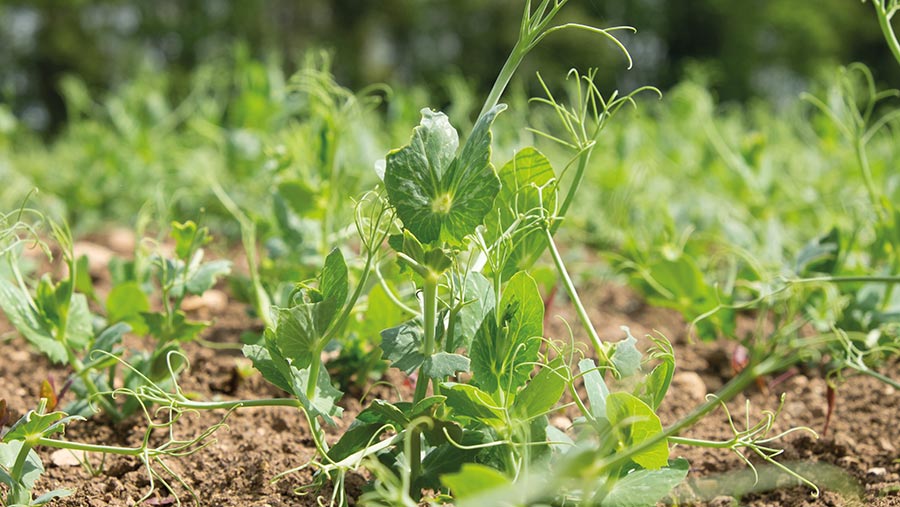Aphid-borne pea virus can ‘cut yields by 40%’
 © Tim Scrivener
© Tim Scrivener An aphid-spread virus, known to affect oilseed rape crops, is now being seen hitting combine pea yields by as much as 40%. This may explain why pea yields have not shown significant increases in recent years.
Turnip Yellows Virus (TuYV) was detected in all 20 pea fields looked at in 2022 – from Aberdeenshire down to Kent and across to Hampshire.
They were assessed following a mild winter, which allowed aphids carrying the virus to thrive. However, the virus did not cause signs of visual damage to crops.
See also: Peas widen rotation and lower input costs for Norfolk grower
Adrian Fox, lead plant virologist at science group Fera, who conducted the field testing set out to discover the prevalence of two well-documented pea viruses in crops, but soon discovered that TuYV was the most damaging to pea crops.
“We found a high incidence of the virus in all the 20 fields which had passed unnoticed before and was leading to a big suppression of yield,” he told a pulses roadshow organised by seed and agrochemicals group Syngenta and the Processors and Growers Research Organisation (PGRO).
Aphids control
To minimise the effect of the virus, he advised growers to follow good aphid management practices – whether that is with insecticide sprays or by encouraging aphid predators – while more research work is undertaken to investigate control methods.
Dr Fox’s three-year study into pea viruses covered 2020, 2021 and 2022, and was funded by the AHDB along with the PGRO.
It aimed to find the incidence level of two well-known viruses – the pea enation mosaic virus and pea seed-borne mosaic virus. These two were found to a limited level, but by far the most serious virus found was TuYV.
PGRO chief executive Roger Vickers added that perhaps the widespread incidence of the virus could well be the reason why pea yields have not progressed in recent years.
In 2020, only about half the pea fields sampled showed the virus, but following a mild winter in 2021-22, all the 20 fields tested in 2022 exhibited the virus, which led to low pea grain size and a low number of pods in crops.
“It was not surprising we found a high level of virus after the mild winter and then the warm spring, which favoured high aphid numbers,” said Dr Fox.
Two key aphids
The virus is spread by two aphids – the peach-potato aphid (Myzus persicae), which spreads TuVY in oilseed rape; and the pea aphid. They have a wide host crop range, such as oilseed rape and brassica weeds.
The potential yield loss from the virus was shown to be of the same magnitude in the state of Victoria, south-eastern Australia, where it caused yield losses of 40% in field peas.
TuYV is the most important viral disease of oilseed rape and can cut yields by up to 30%.
Symptoms usually show in late spring and early summer, appearing as purple tingeing of leaf edges, with pods that can easily be mistaken for frost damage, nutrient deficiency or other stresses.
Peach-potato aphids are resistant to a number of active ingredients.
Therefore, control in oilseed rape is based on management techniques such as using resistant varieties, encouraging natural enemies of aphids and destroying “green bridges” of weeds, forage brassicas and volunteer plants where aphids can survive.
The emergence of TuYV-resistant oilseed rape varieties has helped control the virus in rapeseed.
Dr Fox said further work is needed to see if there are any virus-resistant pea varieties, and it was clear that early virus infection was seen to be more severe compared with later infection.

